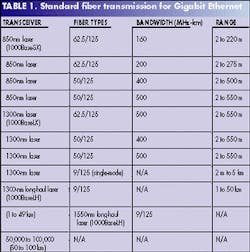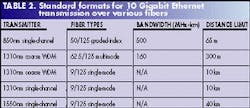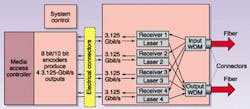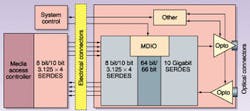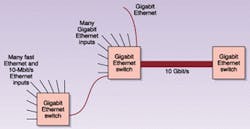
Optics have become increasingly important as each new generation of Ethernet pushes to transmit higher data rates across longer distances. The new 10 Gigabit Ethernet standard is all-optical, specifying transmission through hundreds of meters of high-bandwidth multimode fiber and tens of kilometers through standard step-index single-mode fiber. Gigabit Ethernet can transmit 1 Gbit/s over high-performance four-pair Category 5 copper cable for up to about 100 m, but 10-Gbit/s signals can travel no more than a few meters through either Category 5 cable or the coaxial cable used in the original Ethernet.
The standard for 10 Gigabit Ethernet will not be formally approved until the middle of next year, but the train has been building up steam.1 Members of the 10 Gigabit Ethernet Alliance demonstrated interoperability of their software at the NetWorld + Interop trade show in Atlanta, but it was eclipsed by the attacks on New York and Washington the day the show opened. Vendors already have optical modules available that transmit in standard formats, and the first complete switches are already available. Market conditions have cooled from the fevered pace of a year ago, but 10 Gigabit Ethernet still seems sure to find a variety of applications in high-speed data transmission.
Ethernet basics
Understanding the inner workings of Ethernet requires a short detour into electronic data transmission. Ethernet was developed to move bits through a network of cables linking many computers. From a networking standpoint, the cable operates on the "physical layer," which means that it takes data that computers have packaged into an interchange format such as Internet Protocol, and repackages that data for transmission through cables. Software protocols hide those details from ordinary computer users.
Computers combine the data they transmit into bundles called packets. Each is assigned a header or label, which specifies the destination and other information the network needs to deliver the data to its destination. Packets are bundled together for transmission using a technique called statistical multiplexing, which sends them according to their sequence of arrival and other criteria. The load varies randomly with time and under normal circumstances the average load is well under the peak capacity, so a 10-Gbit/s system may have an average load of only 2 Gbit/s. This differs from the time-division multiplexing technique used for telephone switching, which interleaves sequences of slower input signals to generate a faster signal, and fills any empty slots with dummy data. Thus any system using this technique (also called circuit switching) transmits bits at its rated capacity.
The original Ethernet—still widely used—was designed to distribute data packets at up to 10 Mbit/s, serving up to 1024 nodes attached to a coaxial cable. Each node has its own transceiver, which checks to see if the cable is transmitting another signal before it starts transmitting its own signal. If two nodes start sending signals at the same time, the nodes detect a collision, stop transmitting, and wait a random interval before trying again. The maximum transmission distance is set by the collision detection scheme as well as by signal attenuation in the cable.
A series of later standards stepped data rates up by factors of 10, to 100-Mbit/s Fast Ethernet, Gigabit Ethernet, and 10 Gigabit Ethernet. The data formats are compatible, so the slower speed signals can be fed through an Ethernet switch to the faster versions of Ethernet (see Fig. 1). Because the average load of the input channels is well below their maximum capacity, the total capacity of the input channels can be higher than the output channels. If fluctuating load levels exceed the output capacity, extra packets are held in a buffer until they can be transmitted or they time out.
Instead of one cable transmitting signals among many nodes, both Gigabit Ethernet and 10 Gigabit Ethernet have separate cables that function as point-to-point links between switches, which process packets and direct them out other ports. Each end has its own electro-optic transceiver, so it can send and transmit signals simultaneously in "full-duplex" mode. This removes transmission-time constraints needed to detect signal collisions, so these systems can take advantage of low fiber attenuation to stretch transmission over many kilometers. The switches at the end points must be optoelectronic because the signals must be converted into electronic form in order to read headers and direct the packets.Need for big pipes
Increasing demand for high-speed data services pushed development of Gigabit Ethernet. Initially intended to span distances to a few kilometers to interconnect local-area networks in a campus environment, Gigabit Ethernet was later expanded to cover longer distances in metro networks. The current standard, summarized in Table 1, allows Gigabit Ethernet to span distances to 100 km by transmitting at 1550 nm through single-mode fiber. The Canadian Canarie consortium (Ottawa, Ontario) and companies like World Wide Packets (Veradale, WA) are developing Gigabit Ethernet links to distribute data to business and residential subscribers.The next logical step was to 10 Gigabit Ethernet, and planning proceeded through the peak of the telecommunications boom. Developers envisioned a range of applications, including linking high-speed networks, connecting to data-storage banks, links between high-speed devices, interbuilding links on campuses, and transmitting signals short distances in metropolitan networks. The 10 Gigabit Ethernet standard includes provisions for links using both single- and multimode fiber, and various wavelengths to span distances from tens of meters to 40 km (see Table 2). Some systems can exceed these distance limits, which are intentionally conservative.
For longer-distance transmission, 10 Gigabit Ethernet switches are expected to link with the long-haul telecommunications network, dominated by the synchronous optical network (SONET) standard. Ethernet channels are not fully filled, and unless average loads are high, it's often possible to buffer a 10 Gigabit Ethernet data stream to fit into a single OC-48 2.5-Gbit/s SONET data stream.
Two other standards are emerging for 10 Gbit/s. One is a 10-Gbit/s version of Fibre Channel, a system optimized for high-volume data transfer in storage networks. The other is Infiniband, intended as a high-speed replacement for the venerable PCI data bus inside computers. Infiniband provides for electronic transmission over short distances inside computers or between adjacent devices, and for fiber transmission over longer distances. Neither should compete for the broad range of Ethernet applications, according to Euan Livingston, strategic marketing manager for Agilent's Networking Solutions Division (Santa Clara, CA).
Optics for 10 Gigabit Ethernet
The optics for 10 Gigabit Ethernet come in several different types, optimized for different applications.The standard also provides for 10 Gigabit Ethernet transmission through up to 300 m of older multimode fiber with specified bandwidth of 160 MHz-km. Achieving that distance requires coarse wavelength-division multiplexing (CWDM) with four lasers spaced about 20 nm apart in the 1310-nm window (see Fig. 2). The media access controller processes the input data signals before delivering them to the optical transceiver, adding two extra data bits to each 8-bit byte for error detection, producing four data streams at 3.125 Gbit/s. In the CWDM transceiver shown in Fig. 2, each data stream modulates a separate laser.
The same type of CWDM transceiver can be used with standard step-index single-mode fiber to transmit distances to 10 km. Alternatively, a single 1310-nm laser can be modulated with the entire 10 Gigabit Ethernet signal for single-mode transmission to 10 km. Standard developers provided the two alternatives because it was not clear which would be more economical. The CWDM approach was an early favorite because transmitting the raw 12.5-Gbaud signal produced by adding error detection and correction bits requires an expensive externally modulated laser. Agilent developed a different coding scheme that adds 2 bits to every 64, reducing the raw data stream to 10.3 Gbaud, which a single directly modulated laser can handle (see Fig. 3). The standard now includes the 64/66 coding scheme.
To connect nodes that are further apart in a core network, 1550-nm sources can stretch transmission to tens of kilometers through standard single-mode fiber, The standard calls for transmission over 40 km, but Cisco Systems (San Jose, CA) has introduced a switch with 50-km range.
An emerging market
The slowdown in growth of the telecommunications market has led to some changes in plans, but 10 Gigabit Ethernet still seems poised to fill some high-speed transmission requirements. One is a trend to reconfigure campus networks so all servers are at a central location, rather than scattered one per building. Distributed servers save bandwidth by routing signals to shared resources such as printers and fax lines within the building—but their operation cost is high because technicians have to come to the site for troubleshooting. A central server farm costs much less to operate, but requires higher-capacity links back and forth to each building to serve the traffic within each building.
Another key application for 10 Gigabit Ethernet is metro core networks, such as private networks for large businesses or service providers with multiple points-of-presence in an urban area. The 10 Gigabit Ethernet links interconnect server farms or points-of-presence over distances to 50 km.
Industry groups have made determined efforts to standardize components. In addition to the overall standard promoted by the 10 Gigabit Ethernet Alliance, subgroups have developed standards for transceiver modules and interfaces. The XAUI interface specifies chip-to-chip interconnection. Eighteen companies participated in the September interoperability demonstration. A number of companies led by Agilent and Agere Systems also have agreed on a plug-compatible standard for transceivers called Xenpak.2 Switch and system manufacturers such as Cisco will use these modules in their larger systems.
ACKNOWLEDGMENTS
The author thanks Euan Livingston, Agilent Technologies; Chris Simoneaux, Picolight; and Ben Goldman and Brian Tolley, Cisco Systems.
REFERENCES
- 10 Gigabit Ethernet Alliance (http://www.10gea.org).
- XENPAK (http://www.xenpak.org).

Jeff Hecht | Contributing Editor
Jeff Hecht is a regular contributing editor to Laser Focus World and has been covering the laser industry for 35 years. A prolific book author, Jeff's published works include “Understanding Fiber Optics,” “Understanding Lasers,” “The Laser Guidebook,” and “Beam Weapons: The Next Arms Race.” He also has written books on the histories of lasers and fiber optics, including “City of Light: The Story of Fiber Optics,” and “Beam: The Race to Make the Laser.” Find out more at jeffhecht.com.
